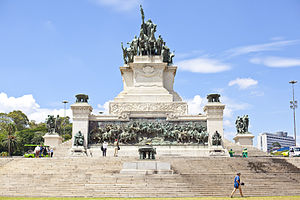| Monument to the Independence of Brazil | |
|---|---|
| Native name Monumento à Independência do Brasil (Brazilian Portuguese) | |
 The monument is located where the Brazilian Independence was declared | |
| Location | São Paulo, Brazil |
| Coordinates | 23°34′49″S 46°36′36″W / 23.58028°S 46.61000°W |
| Founded | 1922 |
| Built | 1884–1926 |
| Architect | Manfredo Manfredi |
| Sculptor | Ettore Ximenes |
| Governing body | São Paulo |
The Monument to the Independence of Brazil (Portuguese: Monumento à Independência do Brasil) is a granite and bronze monument located in the Independence Park in São Paulo, Brazil. It is also known as the Ipiranga Monument (Monumento do Ipiranga) or the Altar of the Fatherland (Altar da Pátria). The monument is located on the banks of the Ipiranga Brook, on the historic site where prince regent Pedro (later emperor Pedro I) proclaimed the independence of the country on 7 September 1822.[1][2]
The monument was designed and built by Italian sculptor Ettore Ximenes (1855–1926) and Italian architect Manfredo Manfredi (1859–1927) to celebrate the first centennial of the Brazilian Independence in 1922.